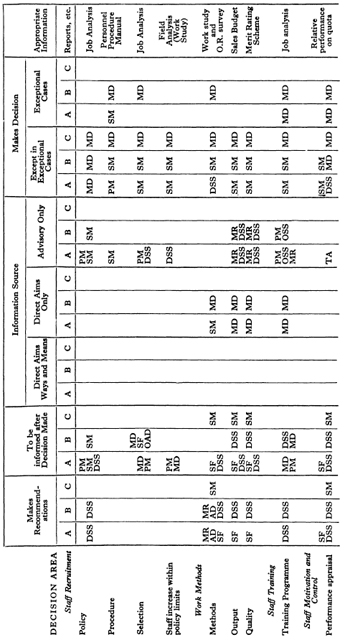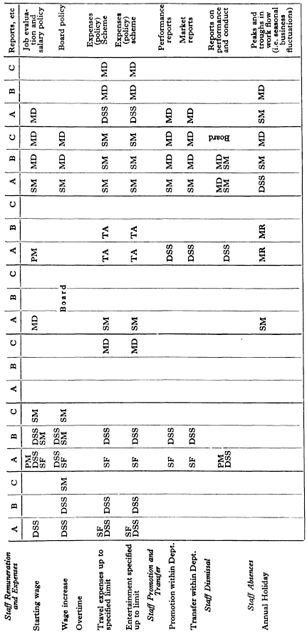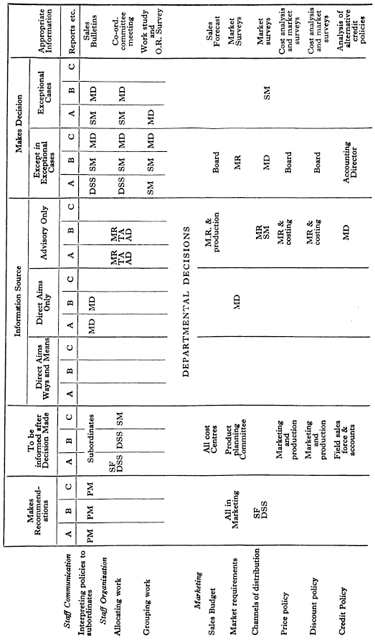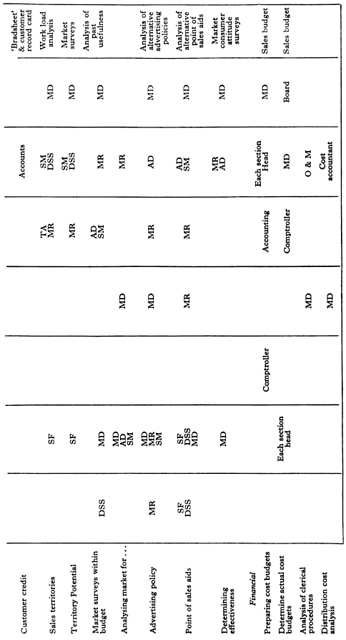STRONGWEAR MANUFACTURING:
ILLUSTRATIVE SYSTEMS STUDY
THE study is concerned with the marketing department of a company operating in the clothing field with a current turnover of about ten million pounds and a sales force of 120 selling to 20,000 retail outlets within the British Isles.
This marketing department is composed of the sections shown below:

The office manager is in charge of order documentation and processing and all customer correspondence. The manager in charge of territory administration produces sales statistics and is concerned with such problems as salesmen's expenses, commissions, territory changes, etc., whereas the sales manager concentrates on controlling selling performance and sales training.
Company Objectives
The aims of the company have never been explicitly stated, but discussion at board level would indicate the following:
Profit. The company is profit oriented and considers a 15 per cent rate of return on total assets to be reasonable. In recent years the profit level has been below this level.
Marketing. The generic need for which the company caters is the need to keep the body covered for comfort, fashion and social reasons. The company caters for several segments of this generic need. In turn, each of these segments can be regarded as generic since the company only caters for some part of each segment. For example, by manufacturing socks and stockings the company caters for the need to cover the foot and lower leg with a soft covering but it only caters for a segment of this need—the adult male's need for a popular-priced, plain sock made from wool or nylon. For the purpose of this broad analysis, a detailed statement on each segment need is omitted. The company aims to sell all its products at current popular prices.
Product Innovation. The company has declared that it intends to produce additional products to satisfy the need for casual, lightweight leisure clothing. It has also declared its intention to abandon production of uneconomic products.
Efficiency. The company is conscious of the fact that its service to customers in recent years has been unsatisfactory. It aims to improve its service by reducing the number of order handling errors and improving the availability of goods, preferably without increasing costs. The company seeks low costs from long production runs by producing a variety of products from the same basic material and design.
Unit Objective
The company aims at achieving a turnover in the next two years of twelve million pounds. The present turnover is ten million pounds. The target turnover has been broken down on a product basis. Market share figures are not currently available. Further investigation reveals that:
(a) a policy of ‘blanket’ selling is in force. In other words, the company's goods are sold to any outlet that is creditworthy and can stock the company's goods;
(b) a further policy, when sales costs as a percentage of turnover exceed 5 per cent, is to reduce the size of the sales force and redistribute to the remaining representatives the accounts in vacated territories.
Even without further analysis it is apparent that both these policies are likely to be inconsistent with company objectives. Blanket selling may be poor strategy as it may lead to servicing uneconomic accounts. A fixed, arbitrary ratio of selling costs to turnover is likely to be in conflict with the profit goal as no account is taken of diminishing returns; a break-even analysis chart is necessary. Finally, the turnover objective is inadequate as an increase in turnover may not mean an increase in profit; cost restrictions need to be imposed.
LISTING DECISION AREAS AND ESTABLISHING INFORMATION NEEDS
Column (1) in the table of Management Information Analysis at the end of this section lists the main decision areas within the marketing department as might be deduced from objectives and interviews with managers. Existing reports, recorded policies, etc., are shown in Column (2) at the side of the relevant decision area. The analysis is confined to the information received and produced by the Marketing Director, Sales Manager and District Sales Supervisor. This restriction is imposed simply to keep the illustrative study within bounds. Ideally, the information system for the company as a whole should be tabulated.
Column (3) shows the originator of the report and Column (4) the destination. The frequency of reporting and the quantity received at the destination are shown in Columns (5) and (6),
In Column (7) are recorded the comments on the inadequacy, etc., of the existing information for the decision to be made. From such an analysis an ideal information system would be developed. In general, there is an absence of control information upon
(i) the field sales force,
(ii) selling costs
(a) uneconomic accounts,
(b) uneconomic channels,
(c) uneconomic products,
(d) salesmen's expenses,
(iii) office efficiency,
(iv) advertising effectiveness and efficiency.
The existing ‘control’ information is also unstructured. Control reports should be structured for the various levels, though, if priorities demanded, all the reports would be available for higher management. As a minimum the Marketing Director would see all control reports once a year for his annual interview and appraisal of representatives.
Planning information is also inadequate in certain major decision areas, for example,
(i) forecasting,
(ii) developing new products and locating market needs,
(iii) recruitment and training.
The market surveys received need to be analysed to draw out their implications for Strongwear. This is at present left to the Marketing Director. Such a busy executive is hardly likely to find time to carry out the sort of marketing analysis needed. It may be more profitable in a company of this size to set up a market analysis section to do this work and to commission other marketing surveys as the need arises.
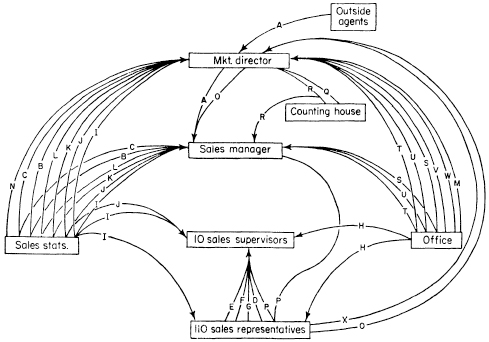
FIG. 35.—Existing documentary information flow within marketing department of Strongwear. Identical forms are shown as having common roots.
Fig. 35 shows the existing information flow within the marketing department. All reports received and produced by the Marketing Director, Sales Manager and District Sales Supervisors are shown except for:
(i) information received by the Sales Manager from production departments about stock levels and proposed new products;
(ii) daily sales bulletin prepared by the Sales Manager and sent out to the field sales force and to all executives within marketing giving information on existing stock levels, and other information useful to field selling.
Fig. 35 points to a number of weaknesses:
(a) there is no exchange of reports between the Sales Manager and the District Sales Supervisors;
(b) information of a detailed nature is sent direct to the Marketing Director and by-passes the Sales Manager; information is even sent direct to the Marketing Director from the field sales force to which the Sales Manager and sales supervisors have no access.
MANAGEMENT INFORMATION ANALYSIS
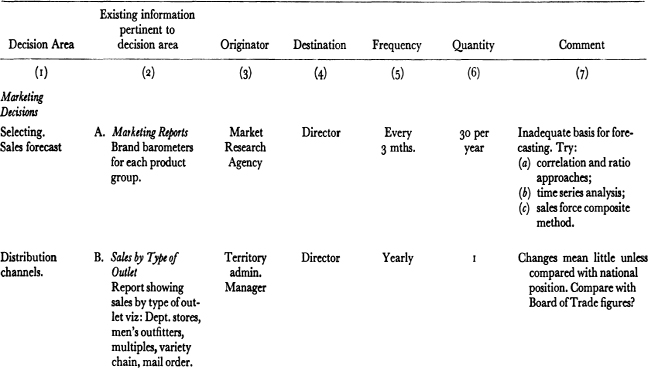

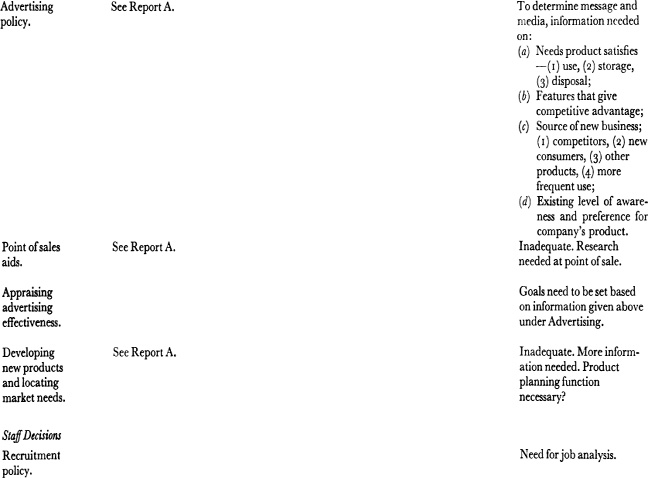

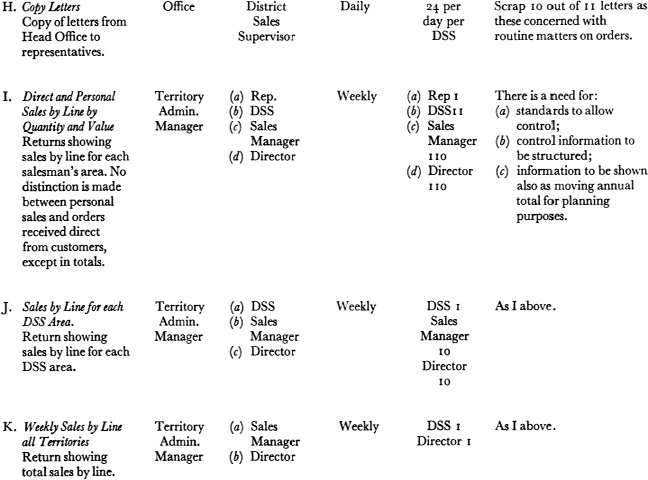
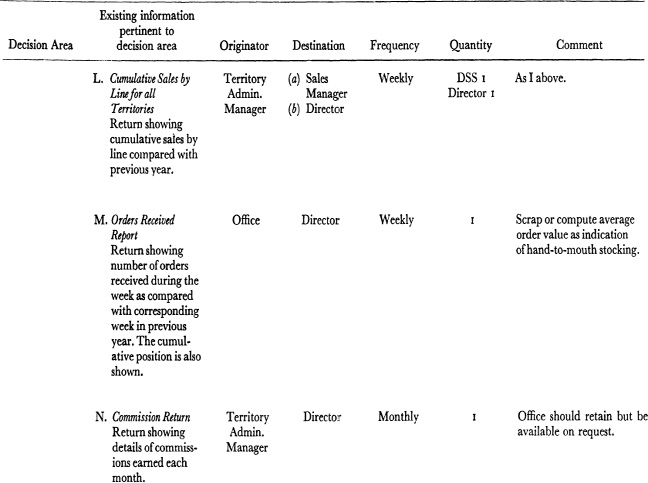
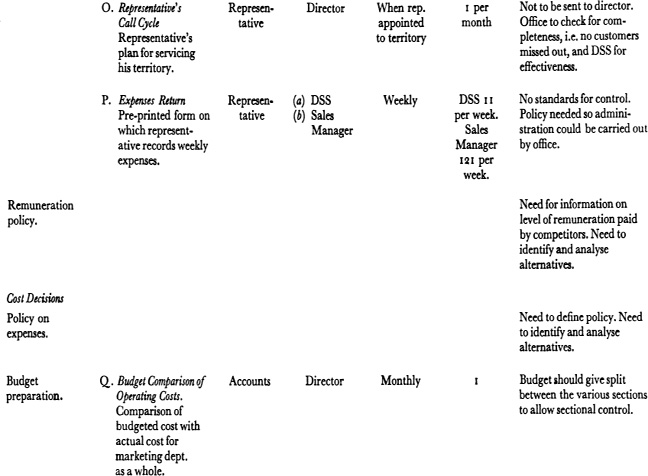
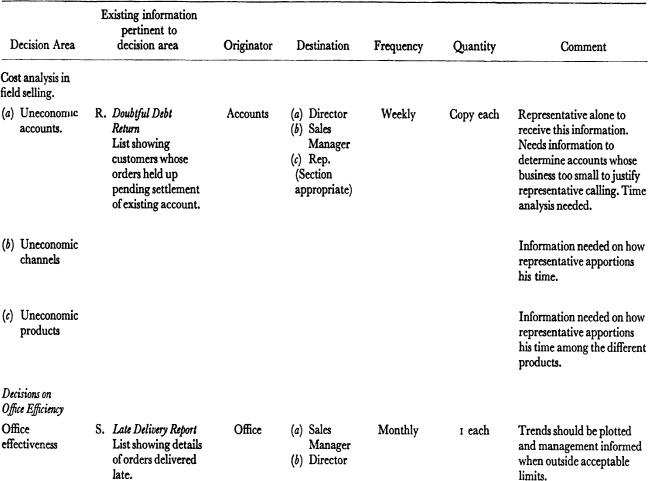

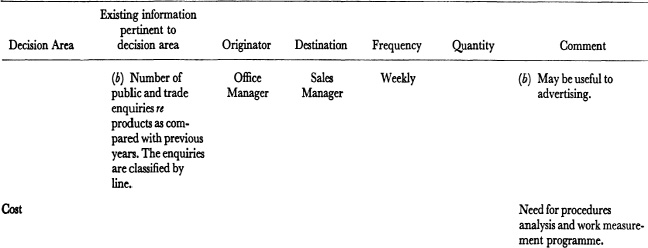
DESIGNING COMMUNICATION CHANNELS FOR THE INFORMATION FLOW, AND GROUPING DECISION AREAS TO MINIMIZE COMMUNICATIONS BURDEN
The decision schedule can be useful in organization work. The schedule shown (Appendix II) is for field sales force and the main marketing decisions. Such a schedule can first be completed to indicate the existing allocation of decision-making authority together with the appropriate communication networks, that is to say the input to the decision-maker and the output from the decision-maker to those to be informed after a decision is made. The schedule can be examined to reduce the communications burden by:
(i) grouping together decision-makers whose work is most inter-dependent; where a person receives or produces information for some decision-maker more than he receives or produces information for any other decision-maker, there may be a case for grouping the two together;
(ii) re-allocating decision-making authority;
(iii) changing the source or distribution of information.
An examination of decision schedules for Strongwear as a whole might suggest a number of organizational changes in the marketing department to improve decision-making and coordination. A revised grouping might be that shown in the chart below.

A market research section would probably be justified by the level of business undertaken, though the actual fieldwork may still be undertaken by outside agents. Without more marketing analysis, company decision-making would be merely speculative.
The territory administration section might be better grouped under the Sales Manager to achieve better co-ordination, as the work of the Sales Manager and the territory administration section are closely interwoven. Finally, the bulk of decisions concerned with customer service may be grouped together. At present, customer correspondence and order documentation come under the Marketing Director but not warehousing and despatch. Such a suggested grouping could only be recommended after examining other decision schedules completed for the company as a whole since a grouping for service may be in conflict with other goals.
Box Abbreviations
AD= |
Advertising Manager |
DSS= |
District Sales Supervisor |
MD= |
Marketing Director |
MR= |
Market Research Manager |
OAD= |
Office Administration Head |
PM= |
Personnel Manager |
SF= |
Sales Force |
SM= |
Sales Manager |
TAD= |
Territory Administration Head |
Column Abbreviations
A= |
Non-Supervisory Level |
B= |
Supervisory Level |
C= |
Manager |
SECTION: FIELD SALES FORCE
